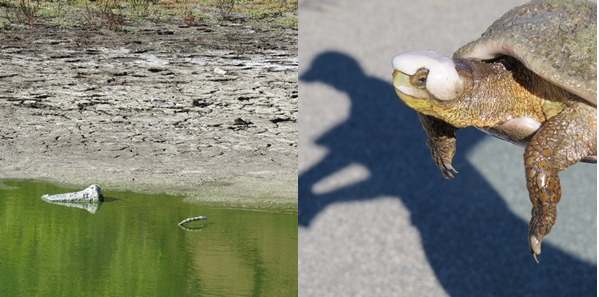
UCLA La Kretz Center ecologists act to save endangered wildlife affected by the extended drought
Dehydrated, emaciated, and stressed, Southwestern Pond Turtles sedentary on the shore of Elizabeth Lake didn’t move, or even try to flee when approached by biologists. This unheard of behavior suggested they were in really bad shape.
Considered a Species of Special Concern, with populations south of Santa Barbara in severe decline for decades, the UCLA La Kretz Center for California Conservation Science stepped in to work with the California Department of Fish and Wildlife to rescue some of the Southwestern Pond Turtles and bring them to UCLA for rehabilitation.
Lying directly on the San Andreas Fault, within the Angeles National Forest, Elizabeth Lake contains one of the largest populations of native pond turtles left in Southern California. With the state suffering from its worst drought in 100 years, the entire ecosystem is being compromised by the ongoing arid conditions.
When full, the lake is about 23 feet deep. Now half or more of it is bone dry, with the rest likely no more than a few feet deep. The previously habitable body of water has become extremely alkaline and salty — negatively impacting the turtles and their invertebrate and vertebrate (fish and tadpoles) prey.
Close to thirty Emys pallida (the scientific name of the species) now reside in large pools filled with fresh water on the roof of the Botany Building, overlooking the university’s botanical garden. The new environment is equipped with places to hide and bask, which is important for the turtles’ well-being. The animals are being fed a high-protein diet that mimics their natural food source and are gaining weight and showing steady improvement.
UCLA La Kretz Center Director Brad Shaffer said, “This is the kind of conservation project the center supports — it saves a very sensitive, declining species and serves to illustrate how we can help promote biodiversity in Southern California.”
Collaborators at the Turtle Conservancy in Ojai also brought turtles from the lake to their facility with a similar plan. Between the two colonies, the ecologists feel they have captured all of the important genetic diversity in the population and can restart the species even if all the other turtles perish.
Given that it is one of the largest, healthiest populations left in that area, both groups felt that pulling out these animals, rehabilitating them, and then putting them back in the wild as soon as possible will allow the greatest chance of ensuring the persistence of the population.
Their shells no longer encrusted with a cement-like mineral coating and having grown accustomed to interacting with their human caretakers, the turtles are healing, socializing, and thriving. The plan is to release the recuperated animals back into Elizabeth Lake after the (hopeful) winter rains refill the lake and restore it ecologically.
